
| Photos From Wyoming Tales and Trails This Page: Thermopolis |
 |

| Photos From Wyoming Tales and Trails This Page: Thermopolis |
 |
|
|
|
About This Site |
 Thermopolis, 1918 Click here for closeup Thermopolis was founding in 1897. The town's name is credited to Joe Magill and Dr. Julius Schuelke and is derived from the Greek words for hot baths and city. The name is thus related to the Greek pass Thermopylae where Leonidas gave his life and those of his men to preserve his city of Sparta. He was reputed to have told the Persians when they demanded tht he put down his arm ????? ?aß?, "Come and get them."
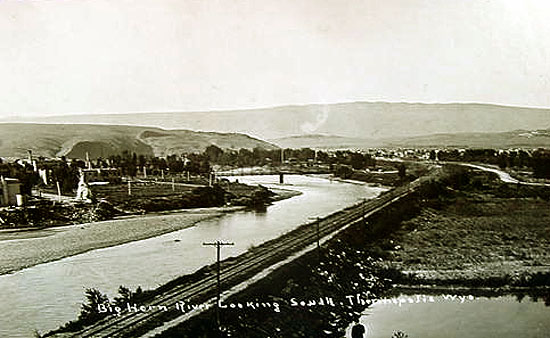 Big Horn River at Thermopolis, looking south, approx. 1910 The conical formation along the river's edge on the left side of the photo is the Teepee Fountain. The Wind River changes its name to the Big Horn River at the entrance to the Wind River Canyon south of Thermopolis. The reason is that each end of the river was named by different exployers and it was not until much later that it was discovered that it was the same river. The Big Horn was known as early as the Lewis and Clark Expedition. The Bonneville Expedition would have been familiar with the Wind River. The fact there was a connection between the two was not known, however, is not surprising. Until a road was laid out through the Wind River Canyon, travel between Shoshoni and Thermopolis was a rough trek through Birdseye Pass. The road was traversable only by stages and light vehicles for only about three months a year. In 1930, The Reverend Nicholas J. Endres described his 1906 two-day journey, as a newly appointed Roman Catholic priest, from Casper to Thermopolis:
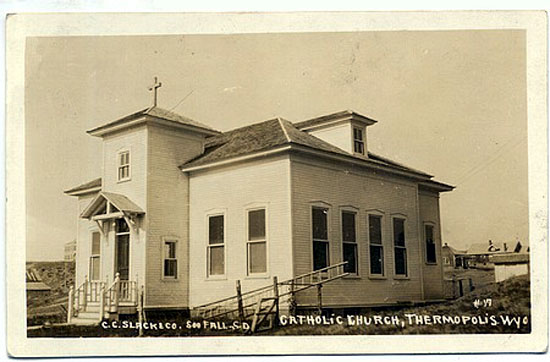 Roman Catholic Church, Thermopolis, 1913 Although the present city on the east side of the Big Horn was not founded until 1897, the area across the Big Horn River on the west side of the river at Owl Creek was settled in 1870 by the Anderson Brothers. The Anderson's original intent was to establish a bean farm, but they ended up founding a town, variously known as Andersonville, Anderson's Hog Ranch, or, after the founding of Thermopolis, "Old Thermopolis." The hog ranch was described by Will Frackleton as being a "long, low building roofed with red shale in which a few weeds had spouted." Inside was the first piano in the Basin. The "professor" playing the piano was George Carwile. Boxes of sawdust served as cuspidors. The customers apparently were not very good in their aim. The damsels were described as being "a bit weather beaten and none too youthful." But, according to Frackleton, they "answered the purpose from several points of view."
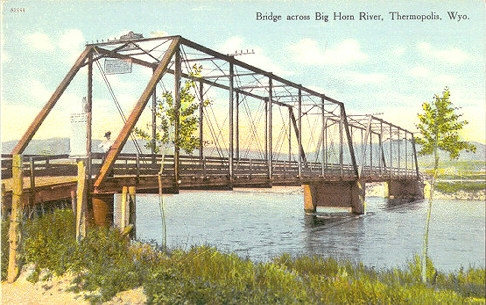 Big Horn River Bridge, Thermopolis, undated
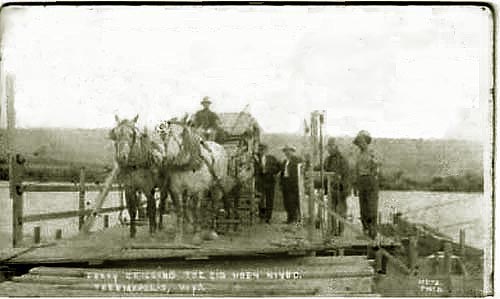 Ferry across the Big Horn, undated. Photo by Arthur O. Metz. The population on the east side of the river was sparse, consisting of Ed Enderly who ran a store, Mrs. Stead who ran an eating house, Neil Cunningham who ran a saloon, Henry Sheard who also ran a saloon, and Ed Sheldon.
 Ferry across the Big Horn, undated. The Wild Bunch celebrated at Anderson's Hog Ranch the Wilcox robbery of the Union Pacific Overland Flyer. The hog ranch was on Owl Creek on the other side of the Big Horn River. The robbery, on June 2, 1889, in which they blew up the mail car, was featured in the movie Butch Cassidy and the Sundance Kid. Indeed, Ed Farlow, later recalled that the area was a headquarters for the Hole-in-the-Wall gang. He noted "It was not unusual to see five or six of these men in one of the saloons at night, drinking and gambling. I was on intimate terms and very well acquainted with all of them and knew their business." Farlow related that those who freqented the area were Butch Cassidy, Al Haimer, Bob McCoy, Jakey Snyder, Dusty Jim, Mike Brown, Jim McCloud, Kise Eads "and one or two lesser lights." Although Butch Cassidy and the Sundance Kid departed for South America in 1903 and the horse thief "Slick" Nard was sent off to prison for the shooting of William Ewing, the area remained infested with outlaws. In July, 1903, Sheriff John J. Fenton of Big Horn County took into custody in Thermopolis Jim McCloud. McCloud was suspected of murder. The Federal Government also wanted McCloud's assistance in their inquiries as to the robbery of the Basin City post office. Twice the Sheriff headed out toward Basin City with his prisoner. Twice the Sheriff had to retreat back into Thermopolis when confronted with outlaws determined to free their comrade. In Thermopolis it was hardly better. A correspondent for the Sheridan Enterprise, July 25, 1903, described the roads leading into Thermopolis as being "lined with armed and mounted men. There were cattlemen, cowboys, sheepowners and herders, farmers and settlers from the surrounding hills." The cattlemen and cowboys apparently wished to free McCloud. The sheepmen also desired to liberate McCloud from the sheriff's custody, but they had in mind demonstrating to McCloud their proposed usage of a telephone pole. The farmers and settlers were there to watch the festivities. McLoud was suspected of having also been a central figure in a brewing war between cattlemen and sheepmen. It ultimately became necessary for the state Adjutant-General, Frank A. Stitzer, to dispatch a unit of the Wyoming National Guard from Basin City to Thermopolis to escort the sheriff and his prisoner on a fast over-night ride back to Basin City. See Report of Adjutant-General dated October 29, 1903. McCloud was sent to Cheyenne where he was housed in the same jail as Tom Horn and escaped at the same time. As was Horn, he was recaptured and served a term in Rawlins. A hold was on him from the federal government and he was returned to Leavenworth from which he had escaped prior to his adventures in Wyoming. Just how secure the Basin City Jail was is debateable. The previous week Sheriff Fenton had removed two murderers from the jail out of fear that the jail would be stormed and the prisoners would suffer the ignominy of an illegal exeution. One of the prisoners,James Gorman, escaped from his handcuffs, swam the Big Horn River, but was recaptured. At 1:00 a.m.,Saturday July 18, the two prisoners were returned to the jail. The sheriff's fears proved justified. At 100 .m. Sunday morning, some 25 or 30 men appeared on the east side of Big Horn River across from Basin City and compelled the ferryman to take them across the river. The men fired a volley through the doors and windows of the Courthouse in which the jail was located. In the volley, a deputy county clerk, C. E. Price, was killed and a deputy sheriff was wounded. The men then used a telephone pole to gain entrance to the jail. According to the [Cody] Wyoming Stockgrower and Farmer account, the mob was unaware that the deputy clerk, had been shot. The men began to batter down the cell door when the second murderer, "suggested," according to the Stockgrower and Farmer that they shoot "at once and end the matter." The men then proceeded to the awaiting ferry, crossed the river, and rode away. Notwithstanding a good description of the leader of the crowd as "a tall and powerfully built man of middle age, giving his orders in a low, firm tone," he went unrecognized. The coroner's jury determined that the two murderers had come to their deaths at the hands of a mob, "the members of which are unknown to the jury." Elimination of McCloud and the death of inmates in the Basin City jail did not, however, end outlawry in the Big Horn Basin. The following year, Sheriff Fenton organized an even larger posse as a result of the attempted robbery the the First National Bank of Cody.
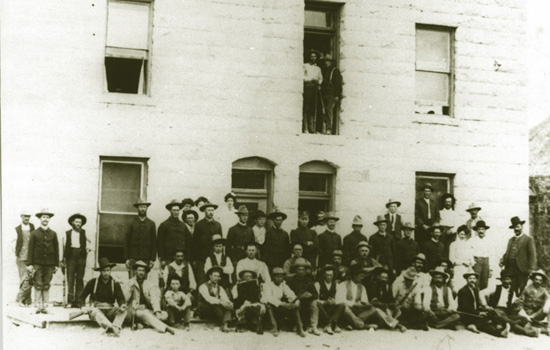 Sheriff's Posse organized by Sheriff J. J. Fenton. Sheriff Fenton, seated fourth from right with rifle in lap. Photo courtesy of Jeff Fenton. On November 1, 1904, in mid-afternoon, two unmasked men entered the First National Bank of Cody across the street from the Irma Hotel. It was believed that several compatriots held horses outside the bank. Within the bank was cashier, Ira Otis Middaugh. The bank was known to hold large amounts of cash to meet payroll and expenses of irrigation projects then underway at Cody. Middaugh exchanged shots with the robbers and then attempted to escape through the back door of the Bank in order to summon help but was shot dead by one of the robbers. The sound of the shots attracted the attention of a party of hunters. As they rode around the corner of the Irma, the robbers opened fire. The hunters returned the fire as town's physician Dr. Frances Margaret Lane, dodging bullets, made her way to Middaugh recumbent form. Within the hotel, the desk clerk took refuge behind the reception desk. Notwithstanding the fusilade of shots reverberating between the buildings on Sheridan Avenue,, the bandidi made good an escape to the southwest in the direction of Meeteetse. An impromptu posse was oganized by duputy sheriff Jeff Chapman which pursued the duo. South of town, the pair had left fresh horses. In a canyon near Meeteetse, the posse lost the trail of the outlaws and returned to Cody awaiting the arrival of Sheriff Fenton. A new posse was organized by Sheriff Fenton. Its size was estimated by the special correspondent for the New York Times "at no less than 100." Late on the evening of November 2, Sheriff Fenton arrived in Thermopolis in an effort to cut the outlaws off. They were believed to be ensconced at Kirby Creek attempting to make it to the Hole-in-the-Wall. Col. Cody's publicity machine immediately swung into action. Cody, then in Omaha hosting some members of the British peerage, had his private car connected to a fast Burlington train and announced that he was lending his best horses to the effort at capturing the murderers and bringing his best Indian Scout, Iron Tail, to lead the effort. "Will we join the hunt? You bet we will. Within ten minutes after our train arrives there we shall be in the saddle with our guns, and away we go. These Englishmen will get a real touch of the Western life such as they never dreamed of," Cody told the press. There is no record that Col. Cody ever actually joined the posse or the hunt. Two weeks later on November 15, the Edwards gambling house in Thermopolis was robbed. With the posse combing the countryside, it was an inauspicious time to rob a gambling saloon. The desperado was captured the next day near Owl Creek. The area around Owl Creek still remains fairly lonely.
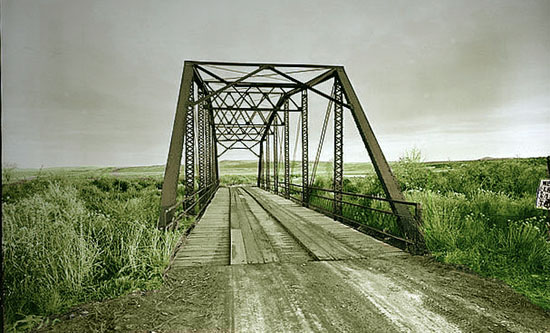 Bridge across the Owl Creek, 5 miles west of Thermopolis, 1981. Next Page Thermopolis continued. |